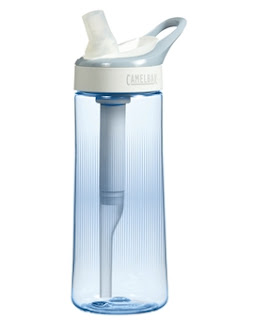Camelbak's UV Water Purifier : the uv light cleans the water by killing harmful bacteria. it takes 90sec or so, and has a timer on the top, and your left with clean drinkable water. i dont think this would work at all for distillation, but it think it might be quite useful as a halfway stage, to clean the water.
CamelBak.com water filtering straw. its quite a nice simple idea, but it seems quite complex in terms of function. its a nice idea though, being able to just drink clean water straight from dirty water. it could possibly be translated to a boating environment.
Vision for Hippo Roller Projects: what is really interesting about the hippo roller is its simplicity, and concept. It could be adapted to a more costal environment. it works because its the simplest possible solution to a complex problem, but also, in terms of accessibility, functionality, cost and deploy-ablility, one of, if not the best thought out and considered clean water device ive found.
Watercone Solar Still Mage Water Management: this is a nice simple idea, and the key thing is that it works with salty water as it works through distillation. so it will provide clean and salt free water in a simple and cheap to produce, robust package.
Lifesystems Chlorine Tablets x 72: chlorine tablets are used in survival situations to to provide drinkable water from spoiled sources. its maybe useable.
Iodine Tincture: same idea as the chlorine tablets. they seem to give water a bad taste though, used more as a last resource than a regular use product.
Sustainable technologies | WaterAid: water aid work with water systems, access and sources for the 3rd world. finding suitable solutions to specific areas with little access to useable water. they have a lot of information both on drinking water quality and sources, both made and more makeshift. Its a really useful resource,.
Treatment of water | WaterAid
http://www.wateraid.org/documents/wa_technology_issue_sheet_2010_lr.pdf
Statistics | WaterAid
Sustainable technology in action | WaterAid
Water Filters UK | canal boats, caravans, campervans static mobile homes: looking at what is already available for boats, these aftermarket and inbuilt pumps came up. they work through reverse osmosis, forcing water through a membrane that only lets water particles through. they are very expensive though, and i think thats why a lot of boats don't seem to have them.
Eco Yachts: Code [e] – A Sun, Wind And Water Powered Yacht - Ecofriend
damien ummel: 'drinkbak' red cross water unit: this is an interesting idea specifically because its so simple and portable. its also simple to use, put water in the top, get water clean at the bottom. it provides very little users attention, which means people can begetting on with other things whilst its filtering water.
c-water by chao gao - iida awards 2010: this works just like the water cone,but being able to put it straight onto wet ground and not having to fill it makes it perhaps more useful as it is minimally time consuming, but highly effective. the compact size is also good, especially for boats with limited space. its something that could be used as and when required and just kept out of the way when its not being used.
jakub szczesny: water purification island: its an interesting concept because its more of a systems based approach, not because you can walk on it. its got a more communal aspect to it than the other products.
bas van der veer: a drop of water and bioplastic planter: using already available collection systems and just adapting them to have another use. it takes advantage of a pre-existing system and just makes it multi functional.
World Resources Institute | Global Warming, Climate Change, Ecosystems, Sustainable Markets, Good Governance & the Environment: its interesting to see where freshwater sources lie and there relation to where they are most used.




